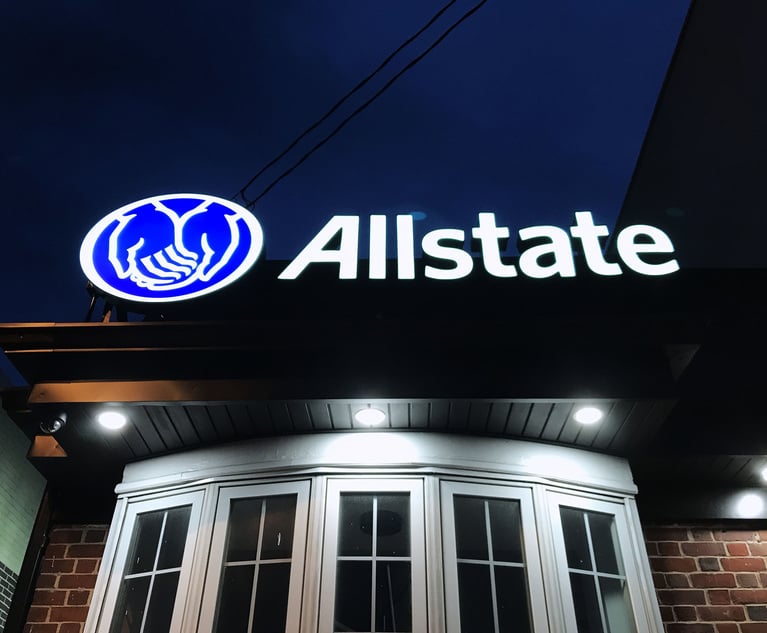Remote Court Appearances Are the New Normal (and That's a Good Thing)
If judges, lawyers, and court reporters can accept the technical challenges and limitations likely to emerge in the early stages, remote court appearances can become the norm to everyone's longer-term benefit.
May 28, 2020 at 01:22 PM
7 minute read
 M. Jude Egan.
M. Jude Egan.
California courts' reopening guidelines require all court appearances to be remote – via telephone or video call. Before the pandemic courtrooms were impossible places for social distancing of any sort. It was not uncommon to have "standing room only" in the small, cramped courtrooms in the three counties in which I regularly practice—San Luis Obispo, Santa Barbara (north and south) and Ventura. Almost two weeks before our courts announced a shut down in early March, I informed our civil court presiding judge that both I and the three lawyers I employed were not going to make in-person court appearances.
Normally, I dislike remote appearances because I am a more effective advocate when I am present in the courtroom. Watching the cases called before mine, I can sense the judge's mood based on how he or she speaks to other lawyers and litigants. During my own case, I can spot nonverbal cues when I am advocating, and when my opposing counsel is speaking. When taking testimony or submitting evidence to the court, I can view it in real-time and observe how witnesses respond to questions. Since much of a judge's responsibility is to determine witness credibility, the judge also needs to view witness reactions to not only the questions asked, but also to what is not asked. I want to see "the whites of witnesses' eyes" when I am cross-examining them, and I want my client to focus on my eyes during direct examination. Remote court appearances by telephone made this next-to-impossible.
However, the pandemic has thrust a new reality upon us. Courts have been closed for 10 weeks. In many civil cases where parties and lawyers are accustomed to long delays between filings and hearings, this 10-week slowdown is little more than an annoyance. Judges routinely set civil matters for 6-month review dates and set trial dates a year in advance. In the family law context, closed courts are a disaster because of the real-time nature of family law disputes. Even in a non-emergency context, how do you tell two high-conflict parents of a 4-year-old—who usually rely on law enforcement to settle most exchanges—that court dates are postponed indefinitely? What happens when a husband in a 30-plus-year marriage simply stops paying spousal support? Or when a husband comes home only to find that his wife has moved out of the house and taken the kids, and has completely emptied the house of all personal items? Each of these situations has happened in my practice during this pandemic.
There is simply no way around it: We need the courts open.
A colleague and I were recently discussing (a) the unease we share about returning to crowded, compact courtrooms, and about how long we think it will be until we feel comfortable again, (b) the risks and benefits of remote court appearances, and (c) what remote appearances mean for access to justice. We agreed that neither of us can imagine sitting in a courtroom for 6-12 months (perhaps 12-18 months). We also agreed that advocacy has its limits when appearing on the phone, but that the increasing prevalence of videoconferencing software is closing the gap between in-person advocacy and remote, telephonic appearances. The ability to see the witness or other lawyer on a video-call changes everything. Some years ago I took a continuing legal education class on "micro-expressions" (taught by a Lie to Me alum) and being very bad at this in person, I found videoconferencing very helpful. Videoconferences focus on close-ups of the face, which allows for an easier read of the micro-facial expressions that tend to tip when a witness is not being truthful.
Ensuring access to justice with remote appearances is an issue the courts must guarantee. Prior to the pandemic companies providing call-in services for the courts had been charging a whopping $86 per party represented per call. They dropped this price about 35% during the beginning of the pandemic, and then dropped it again another 35% to just around $30 per party per call. This reduced price probably makes telephonic appearances possible for unrepresented parties; however, I disagree wholeheartedly with making people pay to make use of something they are already paying for in taxes and filing fees. Videoconferencing software is free, for now, but parties need a stable internet connection, something that many of us take for granted. In the court appearances I have made since the courts have reopened for tentative business, only lawyers have made remote appearances—self-represented litigants have not appeared on those calls.
In family law as many as half of the litigants in the courtroom are self-represented (sometimes even more than half). We cannot tell people they can only use the court system if they have the resources and literal bandwidth to do so, unless we provide places for them to access the technology and also the ability to present evidence before the court (i.e., not just the videoconferencing software, but also the scanners and other technologies needed to get evidence ready for presentation). Providing greater access to the courts through technology can also make the legal process itself less onerous for the poor since they can appear remotely and not miss a day(s) of work.
For lawyers and the future of the modern litigation firm, remote appearances make it possible for a lawyer to appear in more than one jurisdiction on the same day. If everyone is appearing remotely, then effective advocacy should not be an issue—especially if bandwidth problems are resolved by making Wi-Fi free at the courthouse. Plus, the modern litigation firm is built in-part around personal appearances in courtrooms. Hence, why New York firms open California offices. It may be that the increasing prevalence of video appearances becomes the norm. If so, the modern firm will shift from in-person and brick-and-mortar to virtual and diffuse. Lawyers will not be required to live in any particular jurisdiction in order to practice there. Instead of needing to ask permission to appear remotely (as was required pre-pandemic), there will be no in-person appearances. If everyone is appearing remotely, there is no need for a lawyer to be in any particular location. All practices become statewide (we are still limited by state bar membership).
If judges, lawyers, and court reporters can accept the technical challenges and limitations likely to emerge in the early stages, remote court appearances can become the norm to everyone's longer-term benefit. Access issues such as bandwidth availability and free access to software are easily corrected and should improve over time, so it appears remote appearance courtrooms will likely be here to stay. And we should be glad about that.
Jude Egan is a certified Family Law Specialist in California and certified by the State Bar of California, Board of Legal Specialization. He has published internationally in peer reviewed legal, trade and academic journals. He has taught disaster law, business law and federal and state entitlements at the Louisiana State University, E.J. Ourso College of Business. He has recently been featured onLaw.comand in The National Jurist. He has also been named a regular contributor to Family Lawyer Magazine. His website is JudeEgan.com.
Read more:
Co-Parenting in Quarantine: Sharing Custody During the Pandemic, Advice from a Family Law Specialist
This content has been archived. It is available through our partners, LexisNexis® and Bloomberg Law.
To view this content, please continue to their sites.
Not a Lexis Subscriber?
Subscribe Now
Not a Bloomberg Law Subscriber?
Subscribe Now
NOT FOR REPRINT
© 2025 ALM Global, LLC, All Rights Reserved. Request academic re-use from www.copyright.com. All other uses, submit a request to [email protected]. For more information visit Asset & Logo Licensing.
You Might Like
View All
State Appeals Court Revives BraunHagey Lawsuit Alleging $4.2M Unlawful Wire to China
3 minute read

Apple Disputes 'Efforts to Manufacture' Imaging Sensor Claims Against iPhone 15 Technology

Lawsuit alleges racial and gender discrimination led to an Air Force contractor's death at California airfield
7 minute readTrending Stories
Who Got The Work
J. Brugh Lower of Gibbons has entered an appearance for industrial equipment supplier Devco Corporation in a pending trademark infringement lawsuit. The suit, accusing the defendant of selling knock-off Graco products, was filed Dec. 18 in New Jersey District Court by Rivkin Radler on behalf of Graco Inc. and Graco Minnesota. The case, assigned to U.S. District Judge Zahid N. Quraishi, is 3:24-cv-11294, Graco Inc. et al v. Devco Corporation.
Who Got The Work
Rebecca Maller-Stein and Kent A. Yalowitz of Arnold & Porter Kaye Scholer have entered their appearances for Hanaco Venture Capital and its executives, Lior Prosor and David Frankel, in a pending securities lawsuit. The action, filed on Dec. 24 in New York Southern District Court by Zell, Aron & Co. on behalf of Goldeneye Advisors, accuses the defendants of negligently and fraudulently managing the plaintiff's $1 million investment. The case, assigned to U.S. District Judge Vernon S. Broderick, is 1:24-cv-09918, Goldeneye Advisors, LLC v. Hanaco Venture Capital, Ltd. et al.
Who Got The Work
Attorneys from A&O Shearman has stepped in as defense counsel for Toronto-Dominion Bank and other defendants in a pending securities class action. The suit, filed Dec. 11 in New York Southern District Court by Bleichmar Fonti & Auld, accuses the defendants of concealing the bank's 'pervasive' deficiencies in regards to its compliance with the Bank Secrecy Act and the quality of its anti-money laundering controls. The case, assigned to U.S. District Judge Arun Subramanian, is 1:24-cv-09445, Gonzalez v. The Toronto-Dominion Bank et al.
Who Got The Work
Crown Castle International, a Pennsylvania company providing shared communications infrastructure, has turned to Luke D. Wolf of Gordon Rees Scully Mansukhani to fend off a pending breach-of-contract lawsuit. The court action, filed Nov. 25 in Michigan Eastern District Court by Hooper Hathaway PC on behalf of The Town Residences LLC, accuses Crown Castle of failing to transfer approximately $30,000 in utility payments from T-Mobile in breach of a roof-top lease and assignment agreement. The case, assigned to U.S. District Judge Susan K. Declercq, is 2:24-cv-13131, The Town Residences LLC v. T-Mobile US, Inc. et al.
Who Got The Work
Wilfred P. Coronato and Daniel M. Schwartz of McCarter & English have stepped in as defense counsel to Electrolux Home Products Inc. in a pending product liability lawsuit. The court action, filed Nov. 26 in New York Eastern District Court by Poulos Lopiccolo PC and Nagel Rice LLP on behalf of David Stern, alleges that the defendant's refrigerators’ drawers and shelving repeatedly break and fall apart within months after purchase. The case, assigned to U.S. District Judge Joan M. Azrack, is 2:24-cv-08204, Stern v. Electrolux Home Products, Inc.
Featured Firms
Law Offices of Gary Martin Hays & Associates, P.C.
(470) 294-1674
Law Offices of Mark E. Salomone
(857) 444-6468
Smith & Hassler
(713) 739-1250






